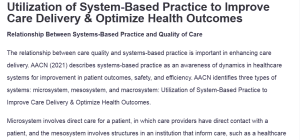Utilization of System-Based Practice to Improve Care Delivery & Optimize Health Outcomes
Relationship Between Systems-Based Practice and Quality of Care
The relationship between care quality and systems-based practice is important in enhancing care delivery. AACN (2021) describes systems-based practice as an awareness of dynamics in healthcare systems for improvement in patient outcomes, safety, and efficiency. AACN identifies three types of systems: microsystem, mesosystem, and macrosystem: Utilization of System-Based Practice to Improve Care Delivery & Optimize Health Outcomes.
Microsystem involves direct care for a patient, in which care providers have direct contact with a patient, and the mesosystem involves structures in an institution that inform care, such as a healthcare institution. The macrosystem involves larger societal factors such as legislation and policies. All these systems interrelate, and individual encounters with systemic policies and practices in care shape care quality.
Social Determinants of Health (SDOH)
Notably, the social determinants of health (SDOH) have a big role in shaping patient outcomes and inequity in care. According to the World Health Organization (2021), SDOH describes environments in which a person is born, lives, works, and ages and in which these environments inform a person’s health. Some of the factors that inform SDOH include financial security, access to care, education, social environment, and living environment, as noted by Flaubert et al. (2021).
Challenges in managing SDOH include a lack of supportive policies, social inequity, and lack of resources. Doctor of Nursing Practice (DNP) and advanced practice nurses (APNs) can make a big contribution in championing systemic interventions for altering these factors in an attempt to counter inequity in care and promote wellness in a population.
Engagement of Innovators and Early Adopters in Change
Consequently, Rogers’s Diffusion of Innovation Theory can effectively explain practice and technology innovation adoption in practice settings. According to Pearson et al. (2023), innovators, for example, will initially implement new technology and practice at risk. APNs and DNPs can leverage early adopters’ willingness to implement new strategies, with early adopters less resistant to new approaches. APNs and DNPs can build momentum and drive widespread acceptance in practice settings, with successful practice integration assured through collaboration with early adopters.
References
AACN. (2021). The essentials: Core competencies for professional nursing education (pp. 1–82). American Association of Colleges of Nursing. https://www.aacnnursing.org/Portals/0/PDFs/Publications/Essentials-2021.pdf
Flaubert, J. L., Menestrel, S. L., Williams, D. R., & Wakefield, M. K. (2021). Social determinants of health and health equity. In www.ncbi.nlm.nih.gov. National Academies Press (US). https://www.ncbi.nlm.nih.gov/books/NBK573923/
Pearson, K., League, R., Kent, M. L., McDevitt, R. C., Fuller, M., Jiang, R., Melton, S., Krishnamoorthy, V., Tetsu Ohnuma, Bartz, R. R., Cobert, J., & Raghunathan, K. (2023). Rogers’ diffusion theory of innovation applied to the adoption of sugammadex in a nationwide sample of US hospitals. British Journal of Anaesthesia, 131(4), e114–e117. https://doi.org/10.1016/j.bja.2023.06.061
World Health Organization. (2021). Social determinants of health. World Health Organization. https://www.who.int/health-topics/social-determinants-of-health
ORDER A PLAGIARISM-FREE PAPER HERE
We’ll write everything from scratch
Question
Discussion Board Guidelines:
- The questions from the readings are intended to engage the student and to demonstrate an understanding of the DNP Essentials and how each DNP Essential relates to practice, leadership, and scholarship.
- You are encouraged to share your worldview from the perspective of a learner-scholar, expert nurse, nurse leader, and/or struggling student in the discussion.
- Last-minute posts do not demonstrate your best work.
- Contributions are evaluated on the presentation of a meaningful ‘informed opinion, in which your ideas are supported by literature, and it includes a synthesis of your preparation on the topic, interaction with peers and faculty, and ongoing learning.
- Substantial posts may include and are not limited to:
- Posting your ‘take’ on the issue, which is informed by your prep and not a gut reaction.
- Asking critical thinking questions to the peers and/or faculty.
- Inviting a collaborative learning experience for the entire group
- Summarizing a discussion or argument or clarifying a point.
- Offering alternate interpretations and additional insights.
- Using at least one reference (i.e., course or outside text/article/resource) to support each posting:
- Note: A link alone is not a reference. All references must be in APA 7th edition format.
Utilization of System-Based Practice to Improve Care Delivery & Optimize Health Outcomes
Discussion Board Instructions:
- The Discussion Board assignment includes only (1) post.
- Initial postings are due by Thursday at midnight (23:59).
- No peer postings are needed.
- Initial postings should be concise and thorough, in one to two paragraphs per question.
Discussion Board Prompts:
Please address any (3) three of these prompts in your initial Discussion Board posting:
- According to the American Association of Colleges of Nursing (AACN, 2021), what is the relationship between systems-based practice and quality of care? What three levels of systems are addressed by the AACN, and how are the systems interrelated? (CO2, CO3, CO4)
- Explain the three levels of explanation for system failures identified by Senge, and provide an example to illustrate each category. (CO3)
- Explain social determinants of health (SDOH) as defined by the World Health Organization (WHO, n.d.). What factors shape SDOH? What are some barriers to addressing SDOH? (CO2, CO3, CO4)
- According to Rogers’s theory, how do innovators engage in the change process? How can the APN/DNP leverage the engagement of early adopters? (CO3, CO4)
- Summarize the purpose of dynamic network theory. What are the eight roles and associated behaviors that may be identified by way of dynamic network theory? (CO2, CO3, CO3, CO4)
Textbook:
- Schadewald, D.M. (2024). Zaccagnini & White’s core competencies for advanced practice nursing: A guide for DNPs. Jones Bartlett Learning. ISBN-13: 978-1284288391 ISBN-10: 1284288390
- Module 5 Resources


